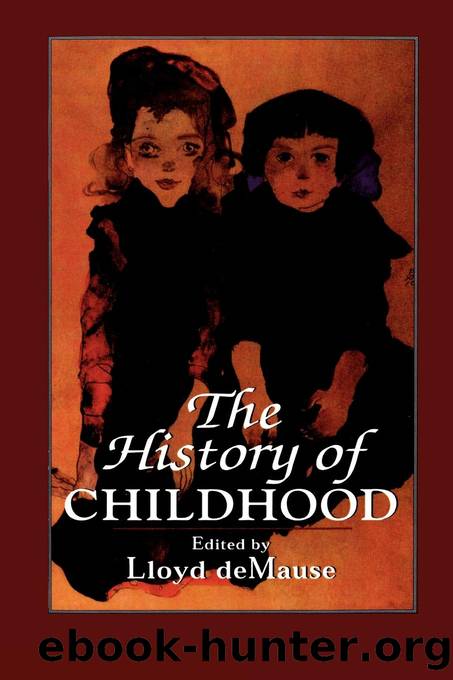The History of Childhood by DeMause Lloyd

Author:DeMause, Lloyd.
Language: eng
Format: epub
Publisher: Jason Aronson Incorporated
Published: 1974-07-14T16:00:00+00:00
REFERENCES
I wish to express my deep appreciation of the invaluable aid I have received from Dr. Gino Corti of Florence in finding, transcribing and interpreting unpublished materials in the libraries and archives of Tuscany, and also of the hospitality I received in September, 1972, at the Villa I Tatti, the Harvard University Center for Italian Renaissance Studies in Florence, from the Director, Prof. Myron P. Gilmore, his wife, the Fellows and the staff.
1. See standard authorities, including George F. Still, The History of Paediatrics (London, 1931); Abt-Garrison, History of Pediatrics (Philadelphia, 1965); and Albrecht Peiper, Chronik der Kinderheilkunde (Leipzig, 1966).
2. Soranus’ Gynecology, tr. Oswei Temkin (Baltimore, 1956); this is seldom if ever named but it is obviously a major source. See M. McLaughlin, “Survivors and Surrogates”, in this volume, n. 42.
3. Ibid., p. 90.
4. Francesco da Barberino (1264-1348), Reggimento e costumi di donna, ed. G. E. Sansoni (Turin, 1957), pp. 189-191 (here translated in prose).
5. According to Soranus (Gynecology, pp. 89-90), “for twenty days the maternal milk is in most cases unwholesome”.
6. Paolo da Certaldo, Libro di buoni costumi, ed. A. Schiaffini (Florence, 1945), p. 233.
7. Soranus, Gynecology, p. 93.
8. San Bernardino of Siena (1380-1444), Sermons, selected and ed. Don N. Orlandi, tr. H. J. Robbins (Siena, 1920), pp. 89-90. There is no complete translation of the works of the saint. The best work in English is by Iris Origo, The World of San Bernardino (New York, 1962) rich in quotations from the sources and equipped with extensive bibliography.
9. Maphei Vegii laudensis De educatione liberorum et eorum claris moribus libri sex, ed. Sister M. W. Fanning and Sister A. S. Sullivan (Washington, D.C., 1933-1936), p. 23. No translation exists but for a study with copious paraphrasing, see Vincent J. Horkan, Educational Theories and Principles of Maffeo Vegio (Wash., D.C., 1953).
10. The influence of Plutarch’s treatise on education, translated by Guarino of Verona in 1411, and of the recovery of the complete text of Quintilian’s works a few years later, is discussed in the classic account of W. H. Woodward, Vittorino da Feltre and Other Humanist Educators (Cambridge, England, 1897; reprinted with an introduction by E. F. Rice, New York, 1970), pp. 25-27 and passim. Plutarch stresses the emotional benefits of maternal nursing, saying, “this fellowship in feeding is a bond that knits kindliness together”; see Moralia, with English translation by F. C. Babbitt (Loeb Classical Library, Cambridge, 1927), I, 15-17.
11. Leon Battista Alberti (1404-1472), I libri della famiglia, tr. by R. N. Watkins as The Family in Renaissance Florence (Columbia, South Carolina, 1969), pp. 51-54; Matteo Palmieri (1405-1475), Della vita civile, ed. F. Battaglia (Bologna, 1944), p. 13, who explicitly mentions “custom”; and, echoing them, the merchant-humanist Giovanni Rucellai (d. 1481), Il Zibaldone Quaresimale, ed. A. Perosa (London, 1960), I, 13.
12. This is clearly stated in an early life of the philosopher Marsiglio Ficino where it is said of his father that although he was poor “we must believe that he lived decently since he sent his children out of
Download
This site does not store any files on its server. We only index and link to content provided by other sites. Please contact the content providers to delete copyright contents if any and email us, we'll remove relevant links or contents immediately.
| Child Abuse | Elder Abuse |
| Partner Abuse |
Should I Stay or Should I Go? by Ramani Durvasula(6799)
The Lost Art of Listening by Michael P. Nichols(6484)
The Rosie Project by Graeme Simsion(5201)
We Need to Talk by Celeste Headlee(4881)
Beartown by Fredrik Backman(4435)
Suicide Notes by Michael Thomas Ford(4278)
Hunger by Roxane Gay(4236)
Ego Is the Enemy by Ryan Holiday(4003)
I Love You But I Don't Trust You by Mira Kirshenbaum(3235)
Mummy Knew by Lisa James(3174)
Crazy Is My Superpower by A.J. Mendez Brooks(2866)
Girl, Wash Your Face by Rachel Hollis(2828)
The Complete Idiot's Guide to Coping With Difficult People by Arlene Uhl(2824)
Toxic Parents by Susan Forward(2812)
Not a Diet Book by James Smith(2742)
The Hard Questions by Susan Piver(2556)
Name Book, The: Over 10,000 Names--Their Meanings, Origins, and Spiritual Significance by Astoria Dorothy(2498)
The Gaslight Effect by Dr. Robin Stern(2356)
The Social Psychology of Inequality by Unknown(2316)
